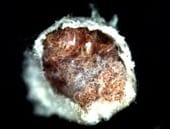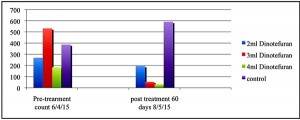Click to Download PDF VERSION
Efficacy of Trunk Micro-injected Dinocide (12% Dinotefuran) against Black Scale (Saissetia oleo) on California Pepper Trees (Schinus molle. Old Ranch Country Club, Seal Beach, California.
August 31, 2015
Conducted by:
Terry Vassey PhD, Golf Course Superintendent, Study Director,
Charles Dodds V.P. J.J. Mauget Co., Research Dept.,
Arnold Farran, Director of Research, Emeritus, J.J. Mauget Co.
Ann Hope Technical Advisor and Field Representative, J. J. Mauget Company.
Abstract
A stand of many heavily infested California Pepper Trees Schinus molle (also known as American pepper, Peruvian peppertree, escobilla, false pepper, molle del Peru, pepper tree, peppercorn tree, Californian pepper tree, pirul and Peruvian mastic) located at Old Ranch Country Club, Seal Beach, California. location approximately 1-2 miles from the Pacific Ocean with soft coastal influences was micro-injected at root crown level approximately 6 inches above soil level with treatments of 2ml, 3ml and 4 ml Dinocide.
Black scale, Saissetia oleae, is a soft scale insect native to southern Africa that is currently an agricultural and horticultural pest in southern Europe, North America, South America, Asia, Australia, and New Zealand. In North America, the insect is distributed in southern and western United States as well as in Mexico and Central America. The insect was introduced to California before 1880 and has since become an economic pest primarily on olive, but it can also cause damage on citrus. Black scale is one of the damaging soft scale pests in California and can be found on numerous hosts including almond, apple, apricot, aspen, bay, citrus, cottonwood, coyote brush, fig, fuchsia, grape, holly, maple, oleander, olive, palm, peppertree, pistachio, plum, pomegranate, poplar, privet, prune, rose, and strawberry tree.
Trail results indicate significant mortality and reduced population levels of immature Black Scale , Saissetia oleae, following an application of trunk injected Dinocide of all three dosage treatments of Mauget’s Dinocide, while scale populations became higher in untreated control trees.
Trial Location:
Old Ranch Country Club, Seal Beach, California. approximately 1-2 miles from the Pacific Ocean with soft coastal influences.
All trees were situated on a well irrigated golf course with several hundred California pepper trees scattered throughout the golf course in clusters and heavily infested with Black Scale.
Random plots of Five trees per plot were selected each containing 1 control tree with no treatment administered per plot.
Five trees per dose rate plus one control tree per plot were sampled.
Five samples of 5 inch stem and leaf bunches per tree where cut, bagged and taken into the laboratory which set up on site where all samples were examined microscopically. Adults, and immature adults where counted on stems and leaves for each sample and recorded.
A pre-treatment sampling was taken June 4, 2015 prior to treatments (Table1).
A sampling was takes on August 5, 2015, 61 days after treatment to determine insect control for each dose rate (Table 1). The difference between pre-treatment and post- treatment for control trees was used to establish the control achieved with Dinocide.
Objectives:
1) The purpose of this study was to evaluate the control of Black Scale, Saissetia ole, using three different dose rates of Dinocide 2ml, 3ml and 4ml containing 12% Dinotefuran.
2) To observe and rate the performance of these treatments as to their effectiveness of action following a single application.
Materials and Methods:
Dinotefuran, the active ingredient in Mauget’s Dinocide, is translaminar, which means that it can pass from a tree’s xylem (the layer in a tree that circulates water from the roots) to its phloem (the tree layer nearest the bark, which transports sugars from the plant’s leaves.) This capability makes Dinocide uniquely effective against pests.
Dinotefuran is an insecticide widely used on forest, woodland and ornamental trees and shrubs and is known for its speed of action. Delivering dinotefuran using Mauget’s patented micro-injection/infusion system is expected to result in superior performance.
Eighteen trees were utilized at a study site beginning on June 4, 2015.
Five trees plus one control tree per plot were selected at random to serve as test subjects.
A total of six trees per plot (five treated and one control per plot) were evaluated.
On June 4, 2015 a pre-treatment count was made on all study trees to determine the severity of Black Scale infestations. .
On June 5, 2015, micro-injected trunk treatment doses of Dinocide were applied to test trees containing 2 ml, 3ml or 4ml.
Each application treatment followed the standard protocol established by the J.J. Mauget Co.,: Diameter at Breast Height (DBH) divided by two to determine the correct number of capsules applied to each tree and then applied at the base or root crown of the trees.
An 11/64-inch drill bit was used to penetrate the crown bark to approximately a 3/8-inch depth into the xylem tissue. Commercial pre-measured capsules containing prescribed pesticide doses were attached by feeder tubes that were inserted into each treated tree. Dinotefuran-treated trees received an injected dose at a rates of 2, 3 and 4 mls of 12% active ingredient per inch of trunk diameter.
Capsules and feeder tubes were removed within 5 hours following treatment. Each treatment and untreated check was replicated 5 times.
Mean tree diameter was used as a criterion to determine standard dosage rates to be micro-injected into the tree trunks at crown level.
On August 5, 2015, 8 weeks after treatments five, 5 inch stem and 5 leaf clusters were again randomly sampled from each treatment and control tree utilizing a pole pruner. Samples were immediately bagged and placed in a cooler and kept for microscopic examination the same day of sampling.
A total of 30 samples per plot were sampled to determine the extent of infestation.
Population levels of adult scales, nymphs on treatment leaves were determined by microscopically examining both collected stems and leaves.
The total number of reductions of new adults and nymphs due to treatments was compared to untreated control trees to determine efficacy of each of the dosages of Dinotetfuran applied.
Results:
A comparison of the insect counts at 60 days post-treatment of both the Dinocide treated and untreated trees on Table 1 indicates a large decrease in the average number of Black Scale insects for the treated trees while higher populations occurred in control trees.. These results would indicate that all 3 dosages of Dinocide injection treatments were directly related to the substantial reduction in scale population in the test samples after 60 days following treatment (Table1).
Conclusion:
All 3 dose rates of Dinocide tested showed significant reduction of Black Scale, Saissetia oleae adult and nymph populations when compared to untreated trees (Table1). Given the ability of Black Scale to quickly reinfest trees, longer residual products, such as J.J. Mauget’s Dinocide have a distinctive advantage over shorter residual materials for controlling infestations.
Discussion:
The reduction in Black Scale population associated with Trunk Injected Dinotefuran, Dinocide by J.J. Mauget Co. injections at all 3 dose rates 2 ml, 3 ml, and 4 ml would indicate efficacy of this systemic insecticide within the 60 days monitored post-treatment experiment.
The major increase in population at 60 days in the control tree population seems to be an indication that scale populations where on the increase while all treated trees in this study showed a marked reduction in population levels demonstrating strong control was achieved.
Due to the known stability of Dinotefuron in tree tissues and acting as a transluminator, one might expect that control of this scale insect may continue in treated Pepper trees for several more months and possibly longer.
Table 1
| Total DBH | Total of 5 treated trees/rate | Pre treatment counts (6/04/15) | Post treatment counts at 60 days (8/05/15) |
| 2 ml Dinotefuran | 53 | 269 | 195 |
| 3 ml Dinotefuran | 84 | 532 | 53 |
| 4 ml Dinotefuran | 61 | 185 | 32 |
| Control | 34 | 378 | 591 |
Literature Cited:
UCIPM: IPM Pests in Gardens and Landscapes, How to manage Black Scale 5/12
JOHNSON and LYONS:Insect and diseases of Trees and plants … Cornell press
WIKIPEDIA: https://en.wikipedia.org/wiki/Schinus_molle
Acknowledgement:
Additionally Dr. Donald Hodel, University of California Extension Specialist for his expertise and advice on scale insects.



